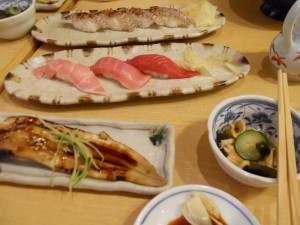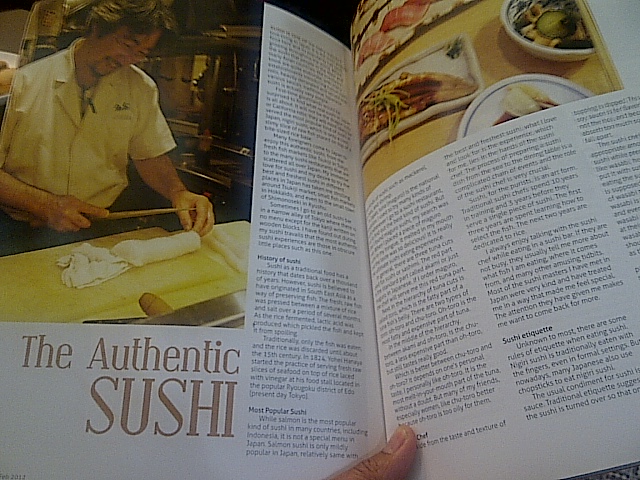
Sushi is one of the many reasons I love living in Japan. It is the most popular food here and its popularity has been growing throughout the world. While the sushi that people in the West and many Asian countries, like Indonesia know are quiet elaborate, with many establishments introducing fusion sushi rolls, heavily decorated and served with various sauces, traditional Japanese sushi is actually very simple.
First time gourmands would be surprised to find what real sushi in Japan is all about. It will not be the dragon rolls or california rolls; they will most likely be served the most popular kind of sushi in Japan, nigiri sushi, which is only a cool, slimy slice of raw fis, placed on top of a bite-sized rice base.
Many foreigners come to Japan to enjoy this authentic sushi, from the fresh fish markets like Tsukiji in Tokyo, to many sushi restaurants that are scattered all over Japan. My immense love for sushi and my desire to try the best and freshest sushi in different places in Japan has taken me strolling around Tsukiji market, small fish market in Hokkaido, and even to the small town of Shimonoseki in Kyushu.
Sometimes I go to an old sushi bar in a narrow alley of Tokyo where there is no menu except for the kanji written on wooden blocks. I have found out during my sushi travails that the most authentic sushi experiences are those in obscure little places such as this one.
History of sushi
Sushi as a traditional food has a history that dates back over a thousand of years. However, sushi is believed to have originated in South East Asia as a way of preserving fish. The fresh, raw fish was pressed between a mixture of rice and salt over a period of several months. As the rice fermented, lactic acid was produced which pickled the fish and kept it from spoiling.
Traditionally, only the fish was eaten, and the rice was discarded until about the 15th century. In 1824, Yohei Hanaya started the practice of serving fresh raw slices of seafood on top of rice laced with vinegar at his food stall located in the popular Ryougoku district of Edo (present day Tokyo).
Most Popular Sushi
 While salmon is the most popular kind of sushi in many countries, including Indonesia, it is not a special menu in Japan. Salmon sushi is only mildly popular in Japan, relatively same with other kinds of sushi such as mackerel, sea bass, and shrimp.
While salmon is the most popular kind of sushi in many countries, including Indonesia, it is not a special menu in Japan. Salmon sushi is only mildly popular in Japan, relatively same with other kinds of sushi such as mackerel, sea bass, and shrimp.
In Japan, tuna (maguro) is the national obsession. I used to try many kind of sushi whenever I go to sushi restaurant, just to find out the best kind of sushi. But after I found maguro sushi, my search was over. When I placed a piece of maguro sushi in my tongue, it melted in my mouth and the taste was so delicious. It is really the ultimate sushi eating experience.
In general, there are three tuna cuts used for sushi or sashimi. The red part is the standard part called akami or just Maguro in Japanese. If I order Maguro, the chef will serve me this red tuna part.
Next in the hierarchy of tuna cuts is called toro, which is the fatty part of tuna fish’s belly. There are two types of toro: oh-toro and chu-toro. Oh-toro is the most fatty and expensive part of tuna.
In the middle of hierarchy, between akami and oh-toro, is the chu-toro, a less expensive part than oh-toro, but still tastes really good.
Which is better between chu-toro and oh-toro? It depends on one’s personal taste. I personally like oh-toro. It is the most melt-in-your-mouth part of tuna, without a doubt. But many of my friends, especially women, like chu-toro better because oh-toro is too oily for them.
Sushi Chef

Aside from the taste and texture of the best and freshest sushi, what I love and look for is the experience, which for me, lies in the hands of the sushi chef. The process of preparing a sushi dish from the sea to the dining table is a complicated chain of events and the role of the sushi chef is very crucial.
Sushi, for the purists, is an art form. Traditional sushi chefs spend 10 years in training and 3 years before they serve a single piece of sushi. The first three years are spent learning how to select the fish. The next two years are dedicated to rice.
I always enjoy talking with the sushi chef while eating in a sushi bar. If they are not busy, they usually tell me more about what fish I am eating, where it comes from, and many other amusing tidbits. Most of the sushi master I have met in Japan were very kind and have treated me in a way that made me feel special. The attention they have given me makes me want to come back for more.
Sushi etiquette
Unknown to the most, there are some rules of etiquette when eating sushi. Nigiri sushi is traditionally eaten with the fingers, even in formal settings. But nowadays, many Japanese also use chopstick to eat nigiri sushi.
The usual condiment for sushi is soy sauce. Traditional etiquette suggests that the sushi is turned over so that only the topping is dipped. This is because the soy sauce is for flavoring the topping, not the rice, and because the rice would absorb too much soy sauce and would fall apart.
The sushi chef will add an appropriate amount of wasabi to the sushi while preparing it. If one doesn’t like wasabi, he can ask the chef not to put it with sushi. Etiquette also suggests eating the sushi as it is, since the chef is supposed to know the proper amount of wasabi to use. However, nowadays, wasabi is more a matter of personal taste, and even restaurants in Japan may serve wasabi on the side for customers to use at their discretion, even when there is wasabi already in the roll. The wasabi should not be mixed with the soy sauce, as this dulls the flavor of the wasabi.
However, in practice, many people, particularly foreigners, ignore traditional sushi-eating methods. It is common to see people mixing large amounts of wasabi into their soy dish and dunking the rice straight into it.
As for me, I use the etiquette as guide, especially when I go out with Japanese friends; after all, sushi is an art form of art. This is what the Japanese do so well, crafting raw fish and vinegar rice to greatness, bringing out its essence, and demonstrating that something so simple and pure is hontou ni oishii – very delicious.
PS. This article is published in Venture Magazine Indonesia, Jan/Feb 2012 Edition, page 68-69


If you want to get social bookmarking backlinks that will help skyrocket your website search engine ranking straight to the top, check out this site http://socialbookmarksubmission.org/
Great article, Turner. I had the paeslure of eating at Sushi Go55 about 4 years ago, and it was a wonderful experience. We ordered large sakes, and they brought us these HUGE bamboo jugs about two feet tall full of delicious sake. After those, we were *almost* as drunk as the sushi chef, who still somehow managed to make some amazing dishes for us. We ordered omakase, and I have no idea what half of the items were, but they were well worth the price. But be warned, the staff spoke no English, and Japanese customers who arrived after we did were seated before us. If you go here, just make sure you know your shit, otherwise you’ll look like a fool!Only other sushi place in LA that comes close to this one is Chiba in North Hollywood. The neighborhood is absolutely terrible and dumpy, but the head chef Shigu makes some amazing specialties. Don’t let his surfer accent fool you – his dad was a world famous Tokyo chef. Highly recommended!